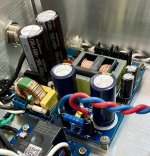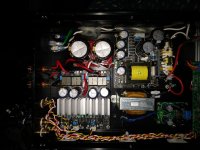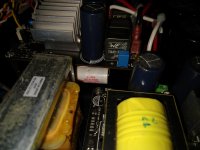D
Deleted member 148505
I'm also using the same power supply SMPS300RS, got the 38V DC output type, but I decided to use 36V so I removed the adjustment pot and placed SMT resistors underneath. (I think the included pot will degrade over time and will mess up the output voltage if I adjust it since it is an open-type pot and was submerged in an insulating varnish).
I also upgraded the caps, the resistor across the output is to bleed the voltage faster on power-off.
I also upgraded the caps, the resistor across the output is to bleed the voltage faster on power-off.
Attachments
What's the value of that resistor (?K, ?W).... the resistor across the output is to bleed the voltage faster on power-off.
D
Deleted member 148505
1.8K, 3W.What's the value of that resistor (?K, ?W).
As a rule of thumb I divide the power rating of the resistor by 4 to get the power dissipation that will not cause the resistor to produce too much heat, specially when chassis ambient temp is high.
Since only 3W resistor can fit between the leads, 3W/4 = 0.75W dissipation is allowed. Then use ohms law to get the desired resistance, and get the nearest value resistor.
If you want faster bleeding, use higher wattage resistor and lower resistance. It's a balancing act, of course you don't want excessive power dissipation and current draw, 1W additional idle power draw I think is too much for a class-D setup lol.
Last edited by a moderator:
3e Audio is out of their 4x100W boards. Any recommendations on substitutes? I'm also open to running 2 2 channel boards.
Okay, hi everyone, I'm coming back for a little feedback. For now, I have made a small test prototype, while waiting for the availability of the 2 other power supplies necessary for my project :


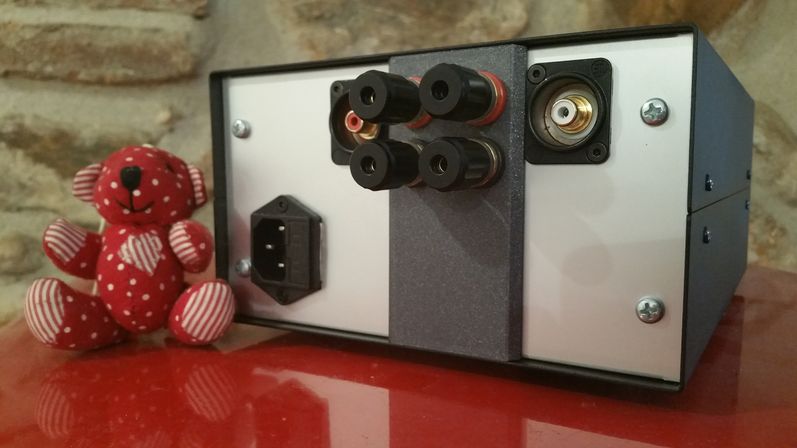
The choice of RCA inputs is voluntary, as it is easily interchangeable with XLR terminals.
Also, As you can see I printed a small offset for the speaker terminals. This is due to the shape of the base of the terminal blocks in question, see for yourself:

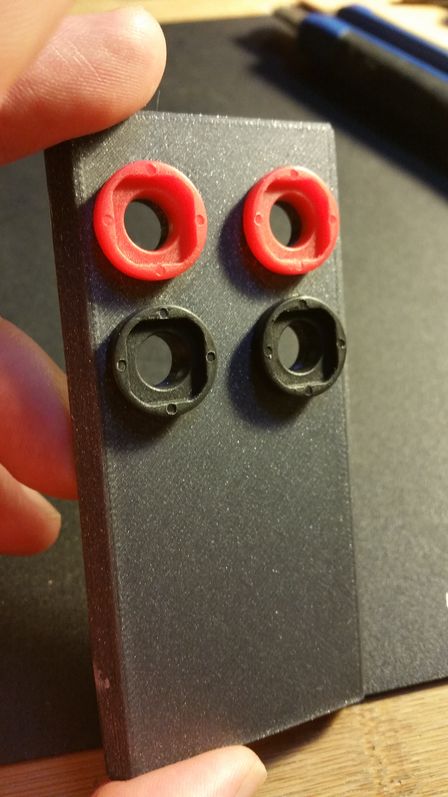
I admit that I did not expect such a qualitative sound rendering! I have not experienced Ncore, Purifi, Benchmark or others but I have non-handicapping hypeacusis, basically almost sonar ears! More seriously, at over 40 years old, I can still hear up to 20kHz and even beyond, also able to discern distortions over the entire spectrum past -50dB. In short, "Super Ears".😉
For now, the amp is paired with a Topping D10s and, for tonight's test, a pair of small Qacoustics 3010s. So clearly, these small speakers cannot go too low in the bass, but they still ensure a coherent sound reproduction for close listening. It's not ideal, but compared to a Marantz PM-6004 it's obviously night and day. Comparing with an FX-Audio D802, which was already more efficient than the PM6004, this little DIY amp is just 2 or 3 notches above! I would like to expand more on my feelings but precisely, it is just feelings (even if they are obvious to me), impressions of clarity, more organic fluidity, more liveliness, more details, more of everything but above all an impression of naturalness, of being very close to reality.
[
- 3e Audio EAUMT-0260-2-B
- Connexelectronic SMPS 300W 36V
- EMI/RFI filter KTEMC 115/230V 3A
- Housing : HIFI 2000 ECO EP1001825
- RCA : Neutrik
- Speaker terminals : EIZZ EZ-301
- Electric cables lying around...
]
EDIT : And I forgot, this is my first DIY assembly in audio electronics. It was quite simple and certainly within the reach of everyone!



The choice of RCA inputs is voluntary, as it is easily interchangeable with XLR terminals.
Also, As you can see I printed a small offset for the speaker terminals. This is due to the shape of the base of the terminal blocks in question, see for yourself:


I admit that I did not expect such a qualitative sound rendering! I have not experienced Ncore, Purifi, Benchmark or others but I have non-handicapping hypeacusis, basically almost sonar ears! More seriously, at over 40 years old, I can still hear up to 20kHz and even beyond, also able to discern distortions over the entire spectrum past -50dB. In short, "Super Ears".😉
For now, the amp is paired with a Topping D10s and, for tonight's test, a pair of small Qacoustics 3010s. So clearly, these small speakers cannot go too low in the bass, but they still ensure a coherent sound reproduction for close listening. It's not ideal, but compared to a Marantz PM-6004 it's obviously night and day. Comparing with an FX-Audio D802, which was already more efficient than the PM6004, this little DIY amp is just 2 or 3 notches above! I would like to expand more on my feelings but precisely, it is just feelings (even if they are obvious to me), impressions of clarity, more organic fluidity, more liveliness, more details, more of everything but above all an impression of naturalness, of being very close to reality.
[
- 3e Audio EAUMT-0260-2-B
- Connexelectronic SMPS 300W 36V
- EMI/RFI filter KTEMC 115/230V 3A
- Housing : HIFI 2000 ECO EP1001825
- RCA : Neutrik
- Speaker terminals : EIZZ EZ-301
- Electric cables lying around...
]
EDIT : And I forgot, this is my first DIY assembly in audio electronics. It was quite simple and certainly within the reach of everyone!
Last edited:
Okay, hi everyone, I'm coming back for a little feedback. For now, I have made a small test prototype, while waiting for the availability of the 2 other power supplies necessary for my project :
The choice of RCA inputs is voluntary, as it is easily interchangeable with XLR terminals.
Also, As you can see I printed a small offset for the speaker terminals. This is due to the shape of the base of the terminal blocks in question, see for yourself:
EDIT : And I forgot, this is my first DIY assembly in audio electronics. It was quite simple and certainly within the reach of everyone!
Very clean and orderly! Nicely done.
I would have intertwined each input’s +&- wires more tightly and not had them cross over the amp on way to their board’s connections. That’s just me. I figure you probably used the wire leads provided with the amp rather than making new ones. The 3e audio class D boards are competent little units.
Cheers
Indeed, I used those provided by 3e Audio. So I hesitated anyway, but ultimately more from fear than harm. No audible interference. Besides, it was supposed to be a test prototype. But, when I hear what I'm hearing right now I tell myself it's really not bad at all.
Indeed, I used those provided by 3e Audio. So I hesitated anyway, but ultimately more from fear than harm. No audible interference. Besides, it was supposed to be a test prototype. But, when I hear what I'm hearing right now I tell myself it's really not bad at all.
The turtle and bear make it that much better ;>)
Yes, haha, it was my little touch to share a little of my good humor ! 😉
Hope you are all well and especially vaccinated!
Hope you are all well and especially vaccinated!

Yes, haha, it was my little touch to share a little of my good humor ! 😉
Hope you are all well and especially vaccinated!
Thank you Sir! The wife & I have been shot up since May/June. Life here (in my area) is drifting back to almost normal (except restaurants can’t find enough servers).
FYI, I attached Mundorf MKP 3.3uF caps across each of the leads of the four big caps on the 3e board (amongst other upgrades) and I thought it gave an improvement in the upper frequency responses and provided a bit more depth to the music. The downside to this was that I had to put 20,000uF caps in between the SMPS and the amp in order suppress the clipping indicator from going off when I drove the amp to louder levels.
Cheers,
Pete
Attachments
yes, same here !turion64 said:except restaurants can’t find enough servers
By "upper frequency" do you mean beyond 3kHz? For my part, on the small Qa3010, the treble seems to me frankly very well treated. The cymbals for example - on the album "Blue Maqams" (Anouar Brahem, 2017) - sound very natural with a very accurate reproduction of the movement of air around them. The Oud is also perfectly transcribed. On these speakers only the double bass seems to lack weight; a bit normal in view of the small 10cm mid-bass speaker.turion64 said:and I thought it gave an improvement in the upper frequency responses and provided a bit more depth to the music
After already more than 6 hours of listening to all kinds of music with it, this TPA3255-based amp seems to tick all the boxes. Once again, I know the limits of my speakers and, obviously on large orchestral productions, they are the limiting link. I will soon be listening on my main system capable of going down honestly but not demeusurely either. But it will already be something else...while waiting to make my own DIY speakers that have been in the works for quite some time.
yes, same here !
By "upper frequency" do you mean beyond 3kHz?
Yes. If all one listens to is MP3s and common modern music CDs, the signal is so compressed and dynamic range is almost absent that any judgement of upper frequency responses & depth become moot. Any decent amp can output the upper registers of these type of recordings (granted some amps really are bad) but it takes a really well designed amp (or careful selection of components) to provide the sparkle & depth needed for wonderfully engineered records of classical & jazz music. If one doesn’t have speakers (and a good listening environment) to finely reproduce the musical spectrum (and I’m not being snobby here; just realistic) you’ll never how vastly different one’s musical experience can be. Many of these class D amps (that cost less than $200 USD) produce great music on small desktop speakers. Listening through headphones may or may not provide one with better answers since the ranges of sound reproduction, across headphone brands, is vast as well.
Blah, blah, blah later….my goal was just to get that sparkle into the capabilities of my 3e Audio amp. If I didn’t have a better amp to compare it to I would have been satisfied with the stock amp. For the money, it is a great buy just as is.
Cheers, Pete
The dynamic range issue is indeed crucial. To take the previous example the album "Blue Maqams" has an average DR of 13 here in its 24bit-96kHz version. the ECM label is really doing a fantastic job on this !turion64 said:Yes. If all one listens to is MP3s and common modern music CDs, the signal is so compressed and dynamic range is almost absent that any judgement of upper frequency responses & depth become moot
No, of course, a neat environment and good speakers capable of reproducing the entire audible spectrum would be ideal. Afterwards, it seems to me that it is as much a question of financial means as of education or, at least, of awareness of listening to music and therefore also of its reproduction.turion64 said:and I’m not being snobby here; just realistic
Implied that they would not be sufficient for larger speakers? In that case this is not necessarily the analysis I would make of it. I do not have enough perspective on this, but if we reduce the subject a little around the rate of distortion according to the power, either with the TPA3255 around 115W (on paper and/or in the best case) in 8ohms at 1% distortion , I don't really see what would limit this kind of amp to small speakers. Even with speakers with low sensitivity there is still enough headroom for reasonable home listening. So this is obviously not the only potentially limiting factor but, despite everything, I am quite surprised by your statement (if it implies the initial question of my answer).turion64 said:Many of these class D amps (that cost less than $200 USD) produce great music on small desktop speakers.
Yes, I can only join you again. It must be admitted that in recent years, quality has become more affordable, at least for the electronic part of reproduction.turion64 said:For the money, it is a great buy just as is
For my part, it's been a few years now that I have a project to make 3-way speakers with active filtering. It took a lot of delay because of other personal and professional projects and also of course because of the pandemic. I already have the speakers (each at 91dB/W/m, 8ohms), the design is ready but quite complex to achieve, which will not prevent me from going to the end of it. Everything will therefore be in active filtering. So an amp per ways. I'm confident that these little amps will do the trick, even with a pair of 12 inches to shake !
For the first time when it's about 27 celsius in the room I heard the fan started with my Mean Well LRS-350-36.
It sounds ugly.
Not an big problem since I cranked it and we don't have it so hot.
An Noctua fan maybe later but I'm a little surprised it started for the first time.
🙂
It sounds ugly.
Not an big problem since I cranked it and we don't have it so hot.
An Noctua fan maybe later but I'm a little surprised it started for the first time.
🙂
Implied that they would not be sufficient for larger speakers? In that case this is not necessarily the analysis I would make of it. I do not have enough perspective on this, but if we reduce the subject a little around the rate of distortion according to the power, either with the TPA3255 around 115W (on paper and/or in the best case) in 8ohms at 1% distortion , I don't really see what would limit this kind of amp to small speakers. Even with speakers with low sensitivity there is still enough headroom for reasonable home listening. So this is obviously not the only potentially limiting factor but, despite everything, I am quite surprised by your statement (if it implies the initial question of my answer).
Most of these newer Class D amps based on the 3251 or 3255 are quite sufficient for larger speakers, no doubt, and the bang-for-the-buck is certainly here now. What I am addressing is the SQ derived from small desktop speakers vs a high quality shelf-type speaker (e.g. Elacs) or a larger floor model. The constant chase of making Class D amps lower and lower in distortion won’t necessarily make them sound more accurate, or special, or musical, or accurate..it just won’t are them sound lifeless or shrill or harsh. Only smart design/engineering, board layout and component selection will bring them to "audiophile" level. The companies that have done that still charge you +$1000 for their Class Ds. But we’re talking about either being able to hear that difference in quality or caring about chasing it as an owner. There will come a point where lowering distortion any further won’t be able to be detected by human hearing.
Certainly Harmonics play a big role in what we appreciate in the music we hear. If the amp is neutral maybe the preamp (or DSP) is the place to introduce it and hopefully any good amp will faithfully reproduce it?
The 3e board is still a great bang for the buck, but so is the modified Aiyama (sp?) and the best bang for the buck is a hand-built amp from drMordor if you can get one.
Cheers
I would have gone well, as I said before, on the DrMordor or JLester amps. Firstly because they seem technically more accomplished and use first-rate components, and secondly to obviously support the community. And believe me, nothing would have made me more happy.
But for my project, I needed three! And, at the end of the day, you have to make a choice in accordance with the allocated budget. So I ordered and received 3 cards from 3eaudio which seemed to me a good compromise (but without romanticism, that's for sure 🙄😉).
But for future projects, why not!?
(In fact it's been a long time since I read the topic and when I see the involvement of Dr Mordor or JLester like others, obviously that makes you want to support each of them ...😉 I also expected to see what Allo was going to come out which, in general, produces rather qualitative products at relatively low prices ... but I understood that it would probably be an integrated ... so there you go.)
But for my project, I needed three! And, at the end of the day, you have to make a choice in accordance with the allocated budget. So I ordered and received 3 cards from 3eaudio which seemed to me a good compromise (but without romanticism, that's for sure 🙄😉).
But for future projects, why not!?
(In fact it's been a long time since I read the topic and when I see the involvement of Dr Mordor or JLester like others, obviously that makes you want to support each of them ...😉 I also expected to see what Allo was going to come out which, in general, produces rather qualitative products at relatively low prices ... but I understood that it would probably be an integrated ... so there you go.)
Last edited:
I would have gone well, as I said before, on the DrMordor or JLester amps. Firstly because they seem technically more accomplished and use first-rate components, and secondly to obviously support the community. And believe me, nothing would have made me more happy.
But for my project, I needed three! And, at the end of the day, you have to make a choice in accordance with the allocated budget. So I ordered and received 3 cards from 3eaudio which seemed to me a good compromise (but without romanticism, that's for sure 🙄😉).
But for future projects, why not!?
(In fact it's been a long time since I read the topic and when I see the involvement of Dr Mordor or JLester like others, obviously that makes you want to support each of them ...😉 I also expected to see what Allo was going to come out which, in general, produces rather qualitative products at relatively low prices ... but I understood that it would probably be an integrated ... so there you go.)
And don’t forget XRK’s Class D offering, although it was truly built for balanced inputs (but he has a workaround circuit for that). They are great units as well, just not as cheap as a 3e or DrM board.
Lester’s are good units too and fun because he’s always suggesting changes to make them better, but if flux is not your thing then stick to buy them and just plug them in type units.
Pete
Last edited:
- Home
- Amplifiers
- Class D
- TPA3255 - all about DIY, Discussion, Design etc
